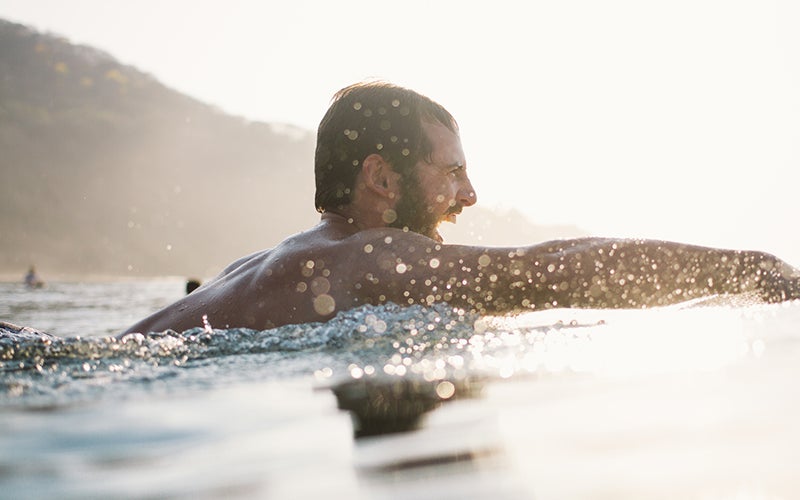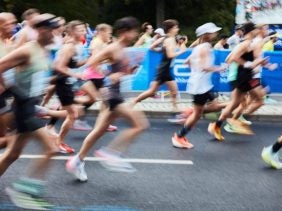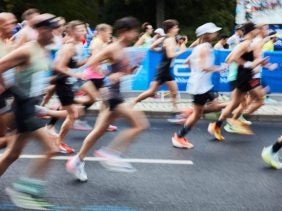8 tips for improving your swimming technique
 ©Melchior_van_Nigtevecht
©Melchior_van_Nigtevecht
Swimming is more than just a popular summer sport; basic swimming courses are available for all ages, and you’re sure to have earned your Seahorse badge when you were a youngster. The Bronze swim badge is considered official proof of being confident in the water. However, being able to stay afloat doesn’t make you a good swimmer.
Improving your swim technique is definitely worth the effort: The more economical your stroke, the faster and more efficiently you’ll be able to swim. You’ll end up saving more energy. That will not only look more elegant, it will also minimize the risk of injury.
Read on for 8 helpful tips that you can use to improve your swim skills so that you not only cut a good figure in the swimming pool on your next visit, but also get the most out of water sports with regard to health.
Related: Swimming – An All-Round Fitness Boost
#1 Get a trainer
Learning technique is difficult and you can’t see the mistakes you’re making when you’re in the water – or your potential and where you’re starting from. And let’s face it: Technique training can be pretty boring and frustrating. Having a coach by your side to correct and motivate you means you’re more likely to stick with it. Plus, you’ll make faster progress. So that it doesn’t stop being fun for you, set yourself 1–2 fixed dates for technique training and allow yourself to still swim for fun on the side.
After swim training, it’s just as important to refuel your muscles with protein* as it is after weight training in the gym. Our Whey Protein Shake is the ideal solution after an intense session in the pool.
#2 Watch how you swim
Seeing how you swim is immensely helpful. Ask your coach or training partner to film you while you’re swimming, and watch the videos and your movements afterward at normal speed and in slow motion. Compare them with videos of professional swimmers. This will help you understand what exactly you need to focus your training on.
Watching yourself can help with more than just swimming. You can find tips on general self-optimization here.
#3 Learn to breathe
That might sound obvious when playing sports, but it isn’t. Breathing correctly is crucial in the water. With the right breathing technique, you’ll be faster, more efficient and more focused – and you’ll avoid unnecessary neck and back problems and swallow less water. Your breathing can also help you relax after your workout.
#4 Glide instead of paddle
A long gliding phase moves you forward quickly, elegantly and economically, so your goal should be to make as few arm strokes as possible per length and to glide for as long as possible. You can achieve this with a clean and powerful swim technique, and by consciously focusing on taking full advantage of the glide phase.
#5 Focus on isolation training
Arms, legs, breathe, glide, don’t swallow water and don’t sink – swimming requires a lot of coordination.. The best way to learn the individual movements is to practice them in isolation.. For example, practice the leg stroke for the crawl while holding a float in your hands and keeping your upper body in the water.
Each movement and swim style can be practiced in isolation with different exercises. Then, once you’ve confidently mastered the individual movements, you can combine them as you swim. Functional training is another way to boost your swim training.
#6 Swim as slow as you can
Concentrate on the whole movement, the breathing, the gliding phase. Take the time to swim slowly. Feel the lightness, power and elegance of moving under water. How easy it is when you swim cleanly. If your focus is purely on clean movements, your body will gradually internalize it until you can swim as fast as you want.
#7 Concentrate on one style
Start with the breaststroke, then the backstroke, then the crawl and – once you find everything easy – the butterfly. Movement in the water takes a lot of coordination. Instead of overwhelming yourself, give your body and head time to learn, one thing at a time. That way you learn everything right the first time. It might take longer at first glance, but it makes much more sense in the long run, as overtraining ultimately only leads to training disruptions.
#8 Follow a training plan
Going swimming when you feel like it is great, but losing weight, building muscle, improving your endurance or getting faster is much easier with a training plan. What it looks like depends on your goal and your starting position. If you want to lose weight and you need some extra support, our Shape Shake 2.0* is a sure-fire way to achieve your goal!
If you’re already a swimmer and used to training with a plan, then review your performance every 6 weeks and adjust your plan if necessary.
This equipment will help your swimming
Strictly speaking, all you need for swimming is comfortable swimwear that won’t slip when you jump into the water or exert yourself.
Swimming goggles are also great for serious swim training. They protect your eyes from chlorinated water so that you can see what’s happening around you without having to lift your head while you’re doing the breaststroke or the crawl. Even if you just want to do a few relaxed laps, you can avoid neck tension with swimming goggles.
In order to prevent water from getting into their ears and nose, many swimmers use nose clips or ear plugsdesigned specifically for swimming . Although they aren’t essential, they are helpful if you have a problem with water in your ears or nose. We recommend trying out this equipment yourself to see if it’s a help or a hindrance.
More interesting articles from foodspring:
- Stand Up Paddle Board: Here’s how efficient the water sport really is
- 7 Amazing Ways to Get Fit Outside – No Running Required!
- Our 5 Best Ways to Get Fit While Having Fun
*Proteins contribute toward an increase in muscle mass.
*Weight loss with Shape Shake 2.0: Replacing two daily meals with one Shape Shake 2.0 each contributes to weight loss as part of a low-calorie diet. Replacing one meal will help you maintain your weight. The product fulfills its intended purpose only as part of a low-calorie diet. A low-calorie diet must also include other foods. Make sure that you drink enough fluids every day. Maintain a varied and balanced diet and a healthy lifestyle.
Sources for this article
We at foodspring use only high-quality sources, including peer-reviewed studies, to support the facts within our articles. Read our editorial policy to learn more about how we fact-check and keep our content accurate, reliable, and trustworthy.



























